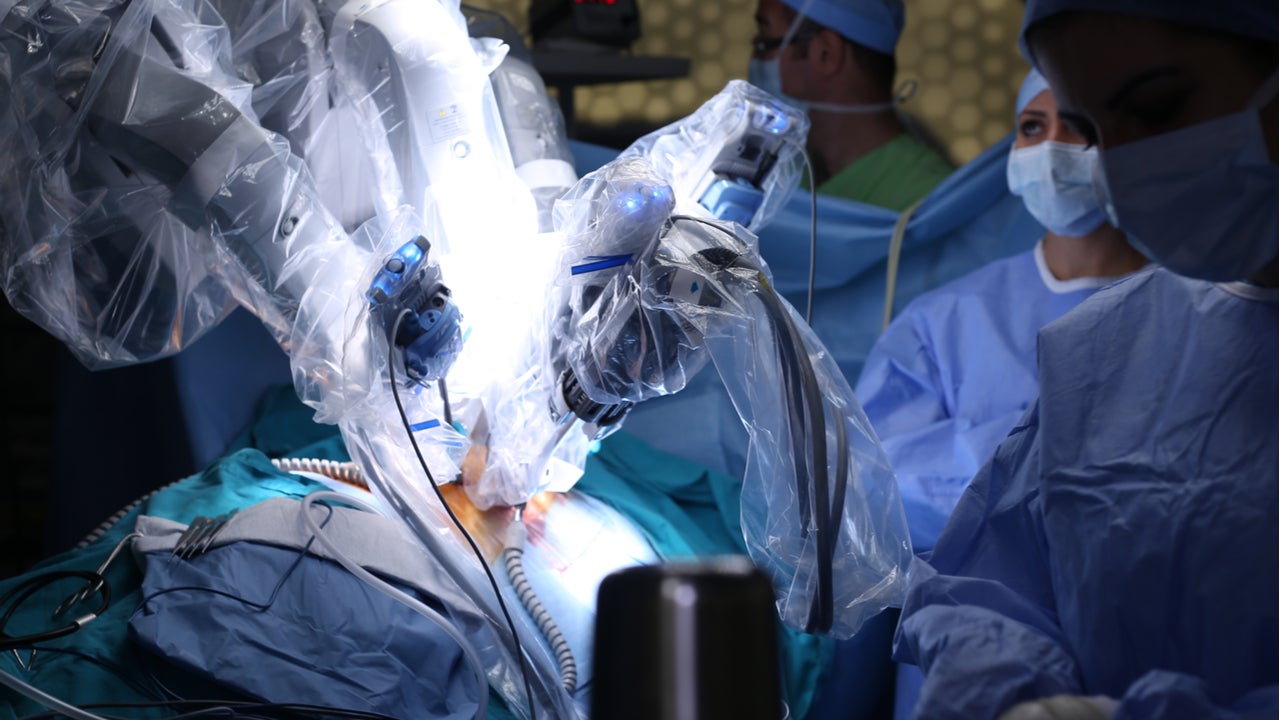Medical robotics is an emerging field in healthcare with the markets for exoskeletons, care robots, and hospital robots currently in the early stage of market development.
Listed below are the medical robotics trends impacting the medical (2021) theme, as identified by GlobalData.
Surgical robots
The surgical robotics segment holds enormous promise, particularly for surgical interventions that require high levels of precision. Major manufacturers are increasing their research and development (R&D) efforts within robotic surgical systems. The overall market is currently dominated by Intuitive Surgical, but the landscape is rapidly changing. The entrance of major manufacturers such as Johnson & Johnson and Medtronic is bolstering the medtech surgical robotics market.
The market is going to see rapid increases, as major organic and inorganic growth is occurring within the industry. The increase in surgical procedures will drive the installed base of surgical systems within hospital institutions.
Future developments in this field will focus more on improving the quality of life of elderly patients by making many procedures less invasive, with a reduction in recovery time and associated cost. Another application of medical robotics is nano surgery, in which micro-robots will be used by surgeons to operate on individual cells.
See Also:
Care robots
Care robots can dramatically cut the cost of nursing elderly patients considering the fact that the global population is ageing, extended families are dispersing, and social welfare budgets are under strain.
How well do you really know your competitors?
Access the most comprehensive Company Profiles on the market, powered by GlobalData. Save hours of research. Gain competitive edge.

Thank you!
Your download email will arrive shortly
Not ready to buy yet? Download a free sample
We are confident about the unique quality of our Company Profiles. However, we want you to make the most beneficial decision for your business, so we offer a free sample that you can download by submitting the below form
By GlobalDataThe number of robots being used to provide care and support to elderly and disabled patients is currently very low but is expected to increase significantly over the next decade, particularly in countries such as Japan that are facing a predicted shortfall in the number of caregivers.
Toyota and Honda have been developing human support robots for many years. Belgian start-up company Zora Robotics is developing eldercare services via customised Alexa-enabled Echo devices. In Japan, Robear has been available on an experimental basis since 2015.
Initial use cases for these products are relatively simple, such as helping people get into and out of bed, but they will increasingly be called upon to perform more complex tasks, from reminding patients when to take medication to providing emotional support and human-like interaction for those lacking regular human contact.
Ageing population
The primary driver of the robotics market is the increasing number of surgical procedures, propelled by the growing global ageing population. The population of individuals aged 60 and over will be approximately 1.5 billion by 2050, which is derived from a 3% annual growth rate according to the United Nations.
Ageing populations are at a higher risk of developing a host of diseases and conditions necessitating the need for surgical interventions. This trend will drive higher volumes of both open and minimally invasive procedures, generating the increased need for robotic surgical systems. Growing surgical procedures are also fuelled by a high rate of global disease burden, with more than 234 million surgical procedures performed globally each year, according to World Health Assembly.
The World Health Organization (WHO) and World Bank expect that by 2026, the burden of diseases requiring surgery will eclipse that of HIV, tuberculosis, and malaria.
Covid-19
GlobalData estimates that 15%–30% of elective surgeries were cancelled due to measures put in place to prevent the spread of Covid-19. Additionally, patients stayed away from hospitals due to the fear of becoming infected.
The overall market for these devices declined in 2020, due to the cancellation of non-essential procedures in Q2 2020. Sales of robotic surgical systems were down by 10% in Q1 2020, 37% in Q2 2020, and 28% in Q3 2020, compared to Q4 2019. The market began to return to pre-Covid-19 levels by Q4 2020.
The hospital robots that are developed for hospital disinfection, however, have been playing an important role during the Covid-19 pandemic. Disinfection robots provide an extra line of defence in healthcare settings. There has been a surge in orders from different geographic regions for hospital robots that sanitise hospital rooms.
This is an edited extract from the Robotics in Medical Devices, 2021 Update – Thematic Research report produced by GlobalData Thematic Research.









